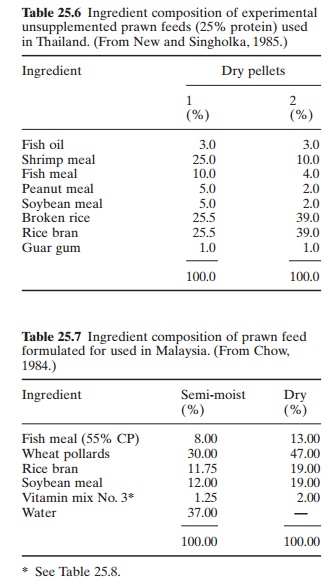Chapter: Aquaculture Principles and Practices: Shrimps and Prawns
Food and feeding - Grow-out of fresh-water prawns
Food and feeding
The types of feed used in fresh-water prawn farming vary considerably,
from locally available feedstuffs to compound chicken feeds and specially
formulated prawn feeds (see D’Abramo and New, 2000). Compared to Penaeid
shrimps, prawns are reported to have a lower dietary protein requirement of
20–25 per cent. However, some farms use shrimp feeds containing higher protein
levels.Also,the results of research seem to indicate that juveniles may
need higher protein levels, and a 40 per cent protein diet has been
reported to yield higher weight gains.Asian farmers use rice byproducts, trash
fish, molluscs, prawn waste, poultry waste and meal of ipil ipil (Lecucaena sp.) leaves.
Many farms use commercially available compound chicken feed, sometimes
reextruded after mixing with trash fish or prawn meal. Tables 25.4–25.8 present
the ingredient composition of a number of practical compound feeds used in
commercial production. At least some of them can be prepared on the farm, if



commercial feeds are not available. In most cases, feeding is
done manually, but
some farmers use automatic blower feeders, as in Hawaii. Many Hawaiian
and Thai prawn farms maintain rich blooms of phytoplankton in thegrowout ponds
to supplement the compound chicken feed or prawn feed.
The feeding rate is adjusted according to assessments of daily consumption and biomass changes. Recommended rates rise from 2.7– 7.4kg/ha per day in the early rearing period to as much as 37.5kg/ha per day towards the end of the rearing, in about six to eight months (New and Singholka, 1985). Feed conversion ratios generally range from 2:1 to 4:1 for com mercial diets, giving growth rates averaging around 1–2cm/month.
Since M. rosenbergii is a benthic omnivore, itis considered a suitable
candidate for polyculture. Experiments in polyculture with Tilapia aureus
(Brick and Stickney, 1979) did not reveal any significant interaction between
the species.
Relatively high combined yields were obtained in polyculture trials with
tilapia, channel catfish and Chinese carp in Alabama (Behrends et al., 1985). However,
the yields and
individual harvest weights of the prawns seemed to indi cate
interspecific competition. In initial experi mental polyculture of the prawn
with Chinese and common carp in ponds without supple mentary feeding, Malecha
et al. (1981) found that weight gains by the prawns compared favourably with
those in monoculture, indicat ing that they could utilize heterotrophic productivity
in manured ponds. Pond fertilizationunder monoculture is likely to reduce the
need for complete compound feeds, making natural food available to the prawns.
In Taiwan, where polyculture is practised with grass carp, bighead carp, grey
mullet or milkfish,
the species combinations are
believed to result in more efficient
use of pond
productivity and the control of the growth of filamentous
algae.
Polyculture of the prawn with the crayfish Pro cambarus clarkii
and the channel
catfish appears to lower the survival and growth rates of the prawns
(Huner et al., 1983).
Related Topics